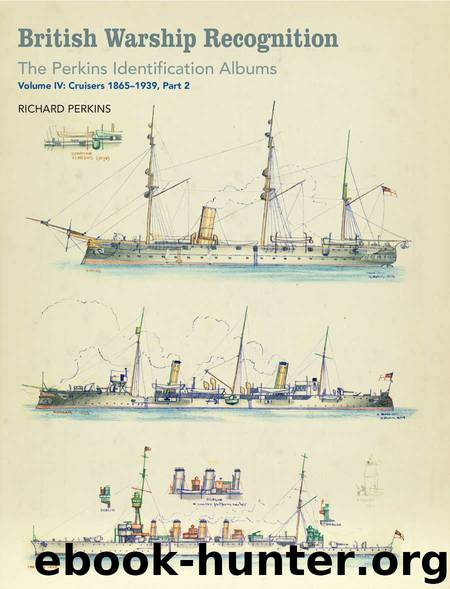British Warship Recognition: The Perkins Identification Albums: Volume IV: Cruisers 1865-1939, Part 2: 4 by Richard Perkins

Author:Richard Perkins [Perkins, Richard]
Language: eng
Format: azw3
Publisher: Seaforth Publishing
Published: 2017-06-30T04:00:00+00:00
Volume 8: An unfinished series of sketches of auxiliary and harbour craft. These include boom vessels, dredgers, lighters, mooring steamers, oil tankers, RNVR drill ships, steam launches, store ships, tugs and water-tank vessels.
In general, the ships are organized by type (e.g., light cruisers), and within these broader categories by class (e.g., Calliope), but note that Perkins listed the members of a class alphabetically and took the first of these as the name-ship. However, the Contents page uses the more familiar official designations: for example, the Chatham class rather than Perkins’s Brisbane class. Each vessel is represented by at least one waterline profile drawing. Ships that enjoyed lengthy careers and/or underwent alterations usually have a number of such drawings to their name. To ensure continuity Perkins employed a template system to produce nearly identical copies of the profiles, as required. Features of interest and minor alterations over time were marked on these in coloured inks (green for items applicable to the whole class and red for features unique to individual ships), while more extensive refits would necessitate a new drawing. It is worth noting that this methodology corresponds closely to that of the Admiralty’s Department of Naval Construction, albeit on a less grand scale.
To supplement his pictures Perkins added notes and detailed views for clarification. For example, his drawing of the protected cruiser HMS Andromache, shown as a minelayer in 1912–14, has a sketch of alterations to the forebridge, and red figures 1 to 4 pointing out minor differences with sister ships. He would often make additional sketches of rig, funnels and minor details like patterns of scuttles and ventilator cowls to assist further in telling sister ships apart. For each class, these observations on the physical appearance of individual ships is rounded out with brief details of deployments, presented in tabular format with dates that can be cross-referenced with the drawings.
As an acquired collection the Perkins albums theoretically enjoy the status of ‘museum objects’, but for a long time they have also been regarded as a ‘working collection’. A number of Perkins’s own written entries are in pencil rather than ink, usually in places where his work had not been completed. These have been supplemented over the years by additional entries (also in pencil) made by the staff of what is now the Museum’s Historic Photographs Section. These normally provide additional information that may not have been available to Perkins, such as more accurate dates for vessel deployments to foreign stations. There are also some additional observations on the physical attributes of certain ships, but it is a tribute to Perkins’s thoroughness that these are few and far between.
Download
This site does not store any files on its server. We only index and link to content provided by other sites. Please contact the content providers to delete copyright contents if any and email us, we'll remove relevant links or contents immediately.
| Automotive | Engineering |
| Transportation |
Small Unmanned Fixed-wing Aircraft Design by Andrew J. Keane Andras Sobester James P. Scanlan & András Sóbester & James P. Scanlan(32693)
Navigation and Map Reading by K Andrew(4973)
Endurance: Shackleton's Incredible Voyage by Alfred Lansing(4635)
And the Band Played On by Randy Shilts(2091)
The Box by Marc Levinson(1905)
Top 10 Prague (EYEWITNESS TOP 10 TRAVEL GUIDES) by DK(1903)
Wild Ride by Adam Lashinsky(1903)
The Race for Hitler's X-Planes: Britain's 1945 Mission to Capture Secret Luftwaffe Technology by John Christopher(1772)
The One Percenter Encyclopedia by Bill Hayes(1764)
Trans-Siberian Railway by Lonely Planet(1670)
Girls Auto Clinic Glove Box Guide by Patrice Banks(1657)
Looking for a Ship by John McPhee(1611)
Batavia's Graveyard by Mike Dash(1588)
TWA 800 by Jack Cashill(1571)
Fighting Hitler's Jets: The Extraordinary Story of the American Airmen Who Beat the Luftwaffe and Defeated Nazi Germany by Robert F. Dorr(1548)
Good with Words by Patrick Barry(1547)
Troubleshooting and Repair of Diesel Engines by Paul Dempsey(1534)
Bligh by Rob Mundle(1524)
Ticket to Ride by Tom Chesshyre(1524)
